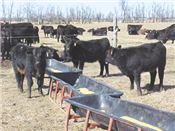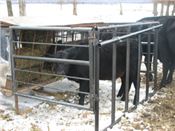Adding Weight To Feeder Calves Can Mean More Profit
MT. VERNON, MO.
Extra weight on a set of feeder calves can translate into more net dollars in the seller’s pocket. “The trick is to put those added pounds on economically without harming the appearance and marketability of the calf. There are many ways to add those pounds with the most popular being to creep-feed,” said Eldon Cole, livestock specialist with University of Missouri Extension.
An unlimited creep ration of high starch feed adds weight but on certain body types of calves they could become too fleshy for the next owner. Fleshy heifers could also have their future milk production reduced from the extra fat in their udders.
As a result of the above negatives, the more popular creep diets now either include a commercial limiter plain salt or they are hand-fed each day in an area where the cows can’t get to it.
Another creep option is high quality hay, usually alfalfa or alfalfa-grass mixed hay. Most cattle owners are surprised at how much of the good hay calves will eat with minimal waste.
Small grains such as wheat, rye and barley are greening up now and a creep gate or strategically placed hot wire fence enables calves to graze the lush spring growth. Wheat pasture can run 20 percent crude protein and 70 percent total digestible nutrients (TDN).
“If you don’t have the small grain pasture, novel endophyte fescue, rye grass, orchard grass mixed with clovers or alfalfa will make a fall-born calf increase its growth rate by 0.25 pound per day or more,” said Cole.
Another method to add pounds is simply keep the fall-born calves on their mothers a bit longer than usual. Some fall calvers like to wean in April and sell the high price per hundred calves at light weight.
“University of Missouri research has shown that holding those calves on the cows through the May-early June period may pencil out more favorably, if forage is available,” said Cole. ∆

Creep feeding by hand
Photo credit: MU Extension

Specially made creep feeder

Solar creep feeder